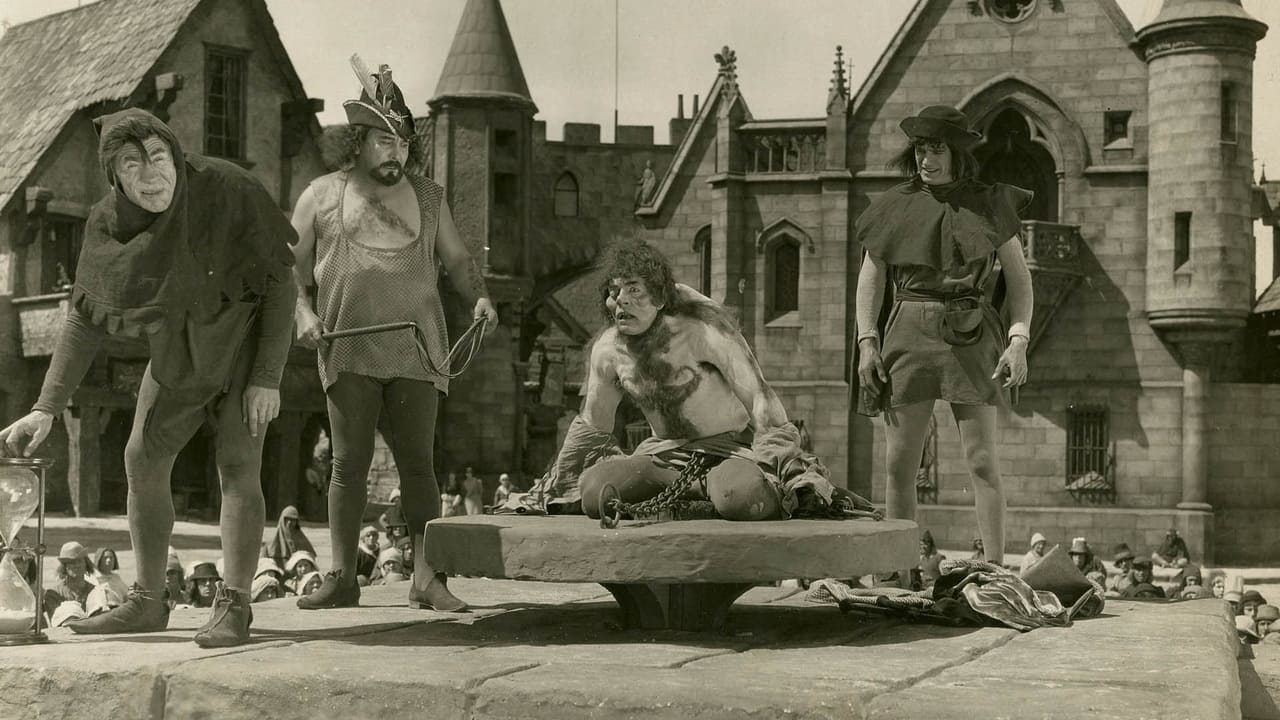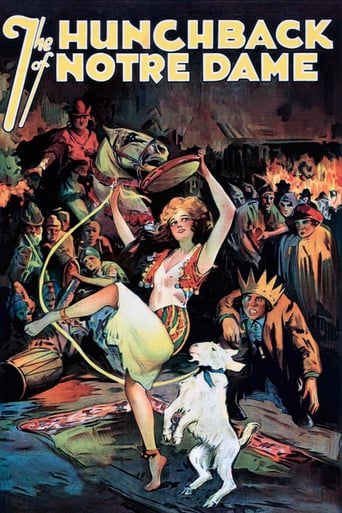Karry
Best movie of this year hands down!
Dorathen
Better Late Then Never
Melanie Bouvet
The movie's not perfect, but it sticks the landing of its message. It was engaging - thrilling at times - and I personally thought it was a great time.
Brennan Camacho
Mostly, the movie is committed to the value of a good time.
JohnHowardReid
Wallace Worsley is not a director who usually figures in any lists of Hollywood masters. In fact, Chaney himself (with whom Worsley worked on no less than five pictures-this is the last of them) once described Worsley as little more than "good as any of the second-raters or better." Well Hunchback is certainly better. A whole lot better! A staggeringly spectacular production, its huge crowds and sets are most artistically angled and photographed. If Wallace Worsley was responsible for these consistently pleasing arrangements of light and color, he is indeed a neglected master.
Ironically, it was due to the fact that he had worked successfully with Chaney at other studios that Worsley was hired in the first place, whereas Chaney's own preference was for Frank Borzage.
Although Hunchback was a rousing success, Worsley was not offered any more work at Universal. In fact, the studio's publicity department regarded Worsley as such a has-been, they didn't even bother to spell his name correctly on the elaborately colorful posters prepared for the film's general release. (They managed to get Lon Chaney's name right though).
In 1924, Worsley followed his Hunchback by directing a minor William Farnum/Lois Wilson vehicle, The Man Who Fights Alone, for Paramount. After that little stint, Paramount's publicity manager, B.P. Schulberg-who had Clara Bow under personal contract, plus his own personal production company(!)-releasing through Paramount of course-hired Worsley for The Shadow of the Law, a no-frills quickie that had only two claims to fame: It starred Miss Bow and was photographed by Ray June. And then came Worsley's final movie, appropriately titled The Power of Silence (1928), an out-of-date Belle Bennett silent from Tiffany-Stahl of Poverty Row.
In addition to his creative visual artistry, Wallace Worsley was also adept at drawing fine performances from his players. Chaney is most effective, Miss Miller utterly charming; while Ernest Torrence, Raymond Hatton and Brandon Hurst almost steal the movie. Tully Marshall would certainly figure on this list too if his role were larger. The only weak spots are Nigel de Brulier, who is mostly quite credible but inclined to overdo the dramatics at times, and Norman Kerry who yet makes his hero considerably less abysmal here than his later effort in Phantom of the Opera.
However it is not the actors, or even Mr Chaney, who constantly engage our attention. It is the overwhelming sets, filled with merry-making and murderous crowds-the whole medieval milieu in fact that Wallace Worsley brings so forcefully and dramatically to life.
AVAILABLE on DVD through Image in a beautifully tinted 117-minute print, well-worn in places but always admirably sharp.
MissSimonetta
This early adaptation of The Hunchback of Notre Dame shares much in common with Universal's later film, The Phantom of the Opera: the sets are great and Lon Chaney is great, but everything else is subpar, including the pedestrian direction of Wallace Worsely.Lon Chaney never gave a bad performance and his performance as Quasimodo was one of his finest moments, both as an actor and as a make-up artist. His is the only fully realized performance in the film and unfortunately, he gets little screen time in comparison to the bloodless love affair between Esmeralda and Phoebus, played by Patsy Ruth Miller and Norman Kerry. Miller does pretty well, though Kerry is pallid and underwhelming, just as he was opposite Chaney in Phantom and The Unknown.I'm not too sure why this is often classified as a horror picture, though it does have its creepy moments, such as Quasimodo stalking Esmeralda at night, intent on kidnapping her for his lecherous master.Overall, this is an alright movie, but nothing compared to the 1939 version, which has more depth and feels more iconic.
Bonehead-XL
When I marathon the Universal Monster movies, this one usually ends up left out. If I was smart, I would say that "Hunchback of Notre Dame" isn't a horror film, instead a period melodrama. While Quasimodo is frequently featured next to Frankenstein and Dracula, the film is low on horror content. The truth is I remember disliking the movie and felt no reason to revisit it. Leaving "Hunchback" out all-together isn't fair though. After all, "Dracula" and "Frankenstein" wouldn't have happened without it.The movie is beholden to the conventions of Hugo and Laemmle. Despite getting title billing, the hunchback isn't featured in large portions of the film. The gypsy Esmeralda's love affair with the captain of the guard Phoebus takes up half the run-time. Hugo's themes of social unrest take stage in this subplot. Esmeralda's adopted father, Clopin, king of the gypsies, plots revolution against the apathetic king. His daughter falling in love with a noble doesn't sit well with the guy. The themes of the haves versus the have-nots are never more apparent then in the scene where Clopin and his thieves storm Phoebus' party. The poor stand on one side of the ballroom, clothed in rags, the rich on the other, in elegant gowns. Even Quasimodo is a gear in the machine of social hierarchy. The film's villain controls the hunchback. When the gypsy girl flares Frollo's lust, he forces Quasimodo to kidnap her. Caught by the guards, the deformed servant suffers for his master's crimes. The hunchback turning against his boss is indicative of the story's overall themes of revolt.Potentially interesting themes are undermined by the commitment to melodrama. Differing from the novel, Esmeralda is saved from the gallows. Following the novel, she is actually royalty, the daughter of a rich woman, kidnapped as an infant by gypsies, her birth mother driven mad by the lost. This information is delivered flatly by a very knowledgeable, exposition-prone bit player. Esmarelda's true identity as a princess doesn't affect the plot much. Frollo's villainous machinations and Quasimodo's rebellion are motivated by their passion for the girl. This would probably be fine if the character had more depth. Patsy Ruth Miller looks elegant but the character is pushed around by the whims of the plot. Phoebus, a cynical womanizer in the novel, is transformed into a bland romantic hero, practically obsessed with the girl. The story of class warfare gets lost amidst the romantic entanglements and period grandeur. Hugo's criticism of the Catholic Church is excised totally, Archdeacon Claude Frollo becoming a kind man of the cloth. The role of villain is shifted to his brother, Jehan. Despite this, Brandon Hurst's performance is a highlight, sneering and glaring from under his cap. Even Hurst gets a romantic moment, confessing his love to the girl in her dungeon prison.Even if he isn't the main character, Quasimodo is the most interesting character. Lon Chaney's performance is legendary. Performing under extensive make-up and a fifteen-pound silicon hump, he conveys pathos with only his body language. The moment when Esmarelda comes to the hunchback's aid as he suffers on the pillory is touching strictly because of Chaney, gratitude clearly visible on his face. Chaney vends the hunchback's love with longing looks, selling the romance better then the script can. Quasi's last act before he dies is to ring the bells, celebrating Phoebus and Esmarelda's love, another memorable moment. Chaney overacts at times, sticking his tongue out and grasping his hands. Still, his performance is probably the best thing about the film. Especially since Quasimodo's evolution to anti-hero is a bit rough. Dropping wooden pillars and boiling lead on innocent, rioting gypsies doesn't exactly endear him to the audience."Hunchback of Notre Dame" isn't a horror film but is still visually spectacular. The sets of Notre Dame are beautiful and moody, Gothic arches echoing through the entire church. The Court of Miracles is another fantastic set, teeming with life in cramped, rocky locations. People in ghoulish skeletons costumes dance out from under dark bridges. Deep shadows seal the eerie atmosphere. An extended visit to a torture chamber is another effective, horrific scene. Ultimately, these elements sell me on the movie, not the overwritten, routine story. I probably prefer Disney's version and the Charles Laughton take appears to be the most critically acclaimed but 1923's "Hunchback" endures for a reason.
Michael Rhodes
With the exception of the 1996 Disney version this is the most famous film adaptation of the 1831 novel of the same name by Victor Hugo. The film is about a deaf, half-blind, and deformed man named Quasimodo who is the bell ringer at the church of Notre Dame in Paris. The movie states that it takes place ten years before Columbus discovered America which would place the film at 1482. Now there is also a beautiful gypsy by the name of Esmeralda who has been adopted by Clopin, the king of the beggars. Esmeralda falls in love with the Captain of the Guard, Phoebus de Chateaupers. However, Clopin disagrees with the crossing of the two classes and starts an uprising plus Claude Frollo (the Archdeacon at Notre Dame) attempts to seduce Esmeralda. The story is overall pretty interesting and it follows the novel much closer than the majority of movie adaptations out there although there are still a few key differences.The acting in this picture is a mixed bag with Lon Chaney stealing the show as Quasimodo. He is amazing and truly looks like he could be a deformed person in that position. Chaney especially does a good job at getting his emotions across without the use of spoken dialogue. Patsy Ruth Miller does an above average job as Esmeralda but with the high budget of this film I expected some better acting with her character. Most of the remaining actors do a pretty good job in their roles but nothing spectacular.When it comes down to the technical aspects of the film it is very impressive for 1923. All of the sets are grand in scope and truly set the time period and location perfectly. Lon Chaney's make up is extraordinarily good with him doing his own makeup. Also the music is very good and a lot of it goes along with the film better than most silent film scores. Where sound effects are used they are used excellently as well.So overall there aren't any major problems with this film but there are some flaws. The story is pretty good but not anything amazing. As for the acting you have Lon Chaney who does a spectacular job while the rest of the cast is merely good but nothing great. Special effects and music are really good in this movie though and they all work very well for the time. In conclusion the movie is flawed but does enough right to make it worth watching so give it a try especially if you enjoyed the novel. Score: 8/10

